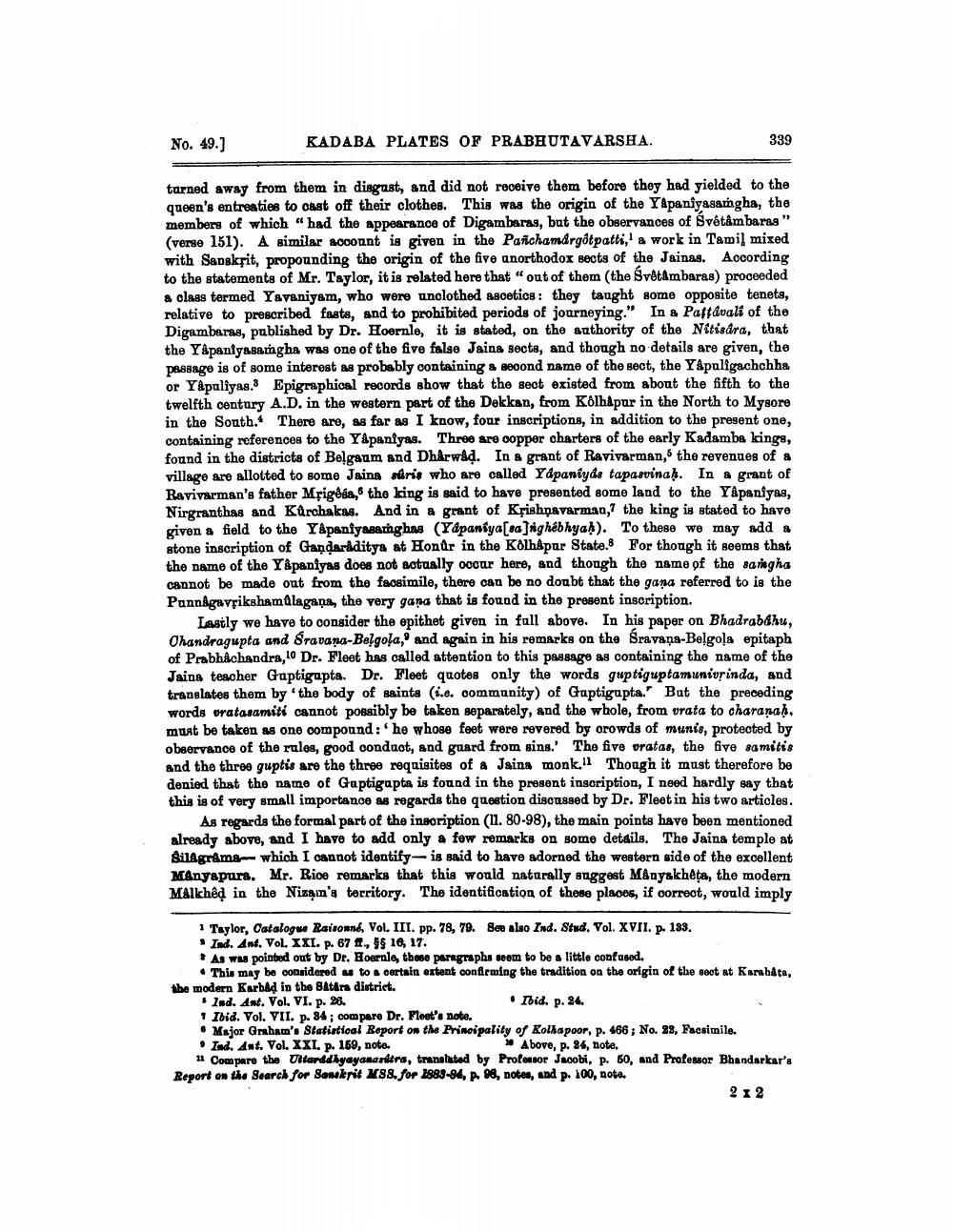________________
No. 49.)
KADABA PLATES OF PRABHUTAVARSHA.
339
tarned away from them in disgust, and did not receive them before they had yielded to the queen's entreaties to cast off their clothes. This was the origin of the Yapaniyasamgha, the members of which had the appearance of Digambaras, but the observances of Švétâmbaras" (verse 151). A similar account is given in the Parichandrgòtpatti, a work in Tamil mixed with Sanskrit, propounding the origin of the five anorthodox sects of the Jainas. According to the statements of Mr. Taylor, it is related here that "out of them (the Svetambaras) proceeded a class termed Yavaniyam, who were unclothed ascetics: they taught some opposite tenets, relative to prescribed faste, and to prohibited periods of journeying." In a Paftavali of the Digambaras, published by Dr. Hoernle, it is stated, on the authority of the Nftisdra, that the Yápaniyasangha was one of the five false Jains sects, and though no details are given, the passage is of some interest as probably containing & second name of the sect, the Yapaligachchha or Yåpuliyas. Epigraphical records show that the sect existed from about the fifth to the twelfth century A.D. in the western part of the Dekkan, from Kolhapur in the North to Mysore in the South. There are, as far as I know, four inscriptions, in addition to the present one, containing references to the Yåpaniyas. Three are copper charters of the early Kadamba kings, found in the districts of Belgaum and Dharwad. In & grant of Ravivarman, the revenues of a village are allotted to some Jaina siris who are called Yapaniyds tapasvina). In a grant of Ravivarman's father Mrigosa, the king is said to have presented some land to the Y&paniyas, Nirgranthas and Kůrchakas. And in a grant of Krishnavarman, the king is stated to have given a field to the Yåpaniyasamaghas (Yapaniya[sanghebhya)). To these we may adds stone inscription of Gandaraditya at Honor in the Kölhåpur State. For though it seems that the name of the Yåpaniyas does not actually oocar here, and though the name of the sangha cannot be made out from the facsimile, there can be no doubt that the gana referred to is the Pannkgavriksham Alagana, the very gana that is found in the present inscription.
Lastly we have to consider the epithet given in full above. In his paper on Bhadrabahu, Ohandragupta and Sravana-Belgola," and again in his remarks on the Sravaņa-Belgola epitaph of Prabhachandra,to Dr. Fleet has oalled attention to this passage as containing the name of the Jains teacher Gaptigapta. Dr. Fleet quotes only the words guptiguptamunivrinda, and translates them by the body of saints (i.e. community) of Gaptigupta." But the preceding words oratasamiti cannot possibly be taken separately, and the whole, from urata to charanaḥ, must be taken as one oompound: he whose feet were revered by orowds of munis, protected by observance of the rules, good conduct, and guard from sing.' The five oratas, the five samitis and the three guptis are the three requisites of & Jains monk. Though it must therefore be denied that the name of Guptigapta is found in the present inscription, I need hardly say that this is of very small importance as regards the question discussed by Dr. Fleet in his two articles.
As regards the formal part of the inscription (11. 80-98), the main points have been mentioned already above, and I have to add only a few remarks on some details. The Jaina temple at Silagrama-- which I cannot identify is said to have adorned the western side of the excellent MAnyapurs. Mr. Rice remarks that this would naturally suggest Minyakheta, the modern MAlkhed in the Nizam's territory. The identification of these places, if correct, would imply
1 Taylor, Catalogue Raisonné, Vol. III. pp. 78, 79. See also Ind. Stud. Vol. XVII. p. 183. . Ind. Ant. Vol. XXI. p. 67 ft., 5S 16, 17. * As was pointed out by Dr. Hoernle, these paragraphs seem to be a little confused,
• This may be considered us to a certain extent confirming the tradition on the origin of the sect at Karahata, the modern Karbad in the Batara district. Ind. Ant. Vol. VI. p. 28.
Ibid. p. 24. 1 Ibid. Vol. VII. p. 84 ; compare Dr. Fleet's note. • Major Graham's Statistical Report on the Principality of Kolhapoor, p. 466 ; No. 39, Facsimile. Ind. Ant. Vol. XXI. p. 169, note
Above, p. 84, note. 1 Compare the Uttarddhyayamandra, translated by Professor Jacobi, p. 60, and Professor Bhandarkar's Report on the Search for Sanskrit X88. for 1983-84, A 98, notes, and p. 100, noto.
2 2




